Plutos, Airball, Barbarian and Sub Battle Simulator
by David Plotkin
I love my Atari ST for the fun it gives me. I also appreciate it for doing word processing and spreadsheets (tax time will be here all too soon) but when the day has been long and trying, there's nothing like sitting down to play a colorful, enjoyable game.
Games come in all shapes and sizes: from arcade shoot-em-ups to Infocom's all-text mind-benders; with role-playing and graphic adventures squeezed in-between. Also falling under "entertainment" (though some don't want to call them games) are simulations, which can allow you (at least partially) to experience real-life adventures: flying a plane, commanding a sub on a war patrol or playing mogul in the stock market.
The theme of this column is entertainment on the ST. I'll review games and simulations I like, and some I don't. I'll also talk about what I believe makes a game "good," trends in current games, and techniques of effective game design.
PLUTOS
Plutos is a scrolling shoot-em-up with a familiar theme: blast everything
that you see. In Plutos, you control a small spacecraft with your joystick.
The view is from overhead, and as you fly over the well-rendered scrolling
landscape, you must deal with ground-based weapons as well as enemy fighters
that loop around you.
Plutos is very simple to play. Pressing the joystick button unleashes your missiles, which will destroy both ground targets and aircraft. However, a few of the ground installations cannot be damaged, and there are even some which will cost you a life if you run into them. In addition, you must keep an eye on your fuel; to refuel, you just blast a fuel tank (marked with an 'F').
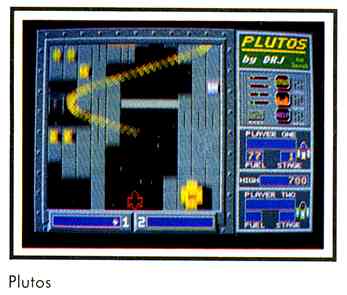
The game is split into levels, each harder than the last, with more enemy aircraft and ground targets firing at you as you progress. By the third level, the air is thick with enemy missiles, and survival is a matter of avoiding missiles and blasting the enemies which are doing the most firing. At the end of each level is a sentry and you must shoot out its eyes with multiple hits or you will be sent back to the beginning of the level again. Blasting certain ground targets will provide you with an extra life.
The scrolling is very smooth and the graphics sharp. A lot of imagination went into designing the layout of each level, and many of the levels look distinctly different. The only problem I see with Plutos is that the "scrolling shoot-em-up" has been done several times on the ST, so you may already own this type of game. But if you don't (or you still want another one), this is an entertaining way to work off your aggressions.
AIRBALL
Airball is one of the strangest games I've ever played-the protagonist
you control is a beachball with a slow leak!
The object of the game is to maneuver this ball through 150 rooms in a mansion, taking care to not puncture your skin on the obstacles lying about. As you go, you must pick up jewels and other scattered treasures. You can also stop at air pumps and reinflate your ball if you're getting too flat. If you can't find an air pump before all your pressure is gone (indicated by a line at the bottom of the screen). then you lose one of your five lives. You also lose a life if your skin is punctured or if you stay on the air pump too long and get over-inflated. Your final objective is to find a "spellbook." I assume if you're successful, then other items will be designated for you to find, but at the moment. I haven't survived long enough to find out.
The view in Airball is in three-quarter perspective, looking down from one corner of the room. You can control your Airball with the mouse, joystick or keyboard keys, although all these ways are difficult. I had the most luck with the joystick turned diagonally so that the direction the ball rolls corresponds to the direction you push the joystick. I found the mouse and keyboard controls very difficult to use. You may choose your mode of control at the beginning of any game, and you can restart the game by pressing F10 to abort and then the space bar to start again.
The protagonist of
Airball is a beachball
with a slow leak!
Control in Airball is crucial, because a mistake can bump you against a sharp object, with disastrous results. After you play a while, you get the feel of controlling the ball, but be prepared for some short games when you first get started. Besides controlling the direction, you can also control when to pick up an object and when to make the ball "hop" to climb stairs.
Airball's graphics are very good. Each room contains a wealth of detail, including jewels, kettles, statues, stairs, archways, cobblestone floors, spikes (look out for these) and green slime (also deadly). If you puncture yourself, then the deflating ball zips through the air in an amusing display. Airball also includes an excellent soundtrack.
You'll find it necessary to map your progress as you play, or you'll get hopelessly lost in the maze of rooms. Unfortunately, stopping to map each room can get tedious, so I just tend to play and try to remember where I am going as best I can. Airball is an original game that I recommend to those with steady nerves and a sense of adventure.
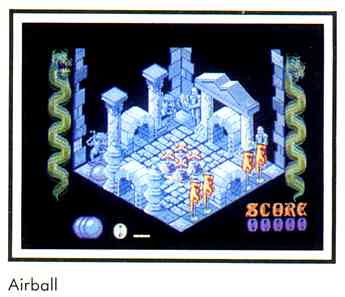
BARBARIAN
Barbarian is a graphically stunning action adventure. In it you guide
Hegor. the hero, through many perils to rid the land of an evil force that's
devastating fields and killing the villagers. Your final goal is to become
King, but to claim the title, you must defeat the minions of the evil wizard
Necron.
Both Barbarian's storyline and hero are reminiscent of the "Conan" movies, down to the flowing hair and well-muscled body of Hegor. As the game begins, Hegor is standing in a field, wielding his only possession: a sword. As with Airball (above) you can control Hegor's actions with the joystick, mouse or the keyboard. A line of icons stretches across the bottom of the screen, indicating stop, jump, run, attack, defend, flee and direction of movement. You may activate any of these actions by clicking on the icon with the mouse or pressing the appropriate keys. For example, the cursor arrow keys control direction, and you can use either [J] or [F5] to make Hegor jump. You may also pick up or drop objects as you go along.
Although the number of controls for Hegor's actions are limited, how Hegor responds to a particular control depends on the situation. For example, he will swing his sword differently against an axe-wielding opponent than a clawed ghoul. This makes for a wide range of motions from a small number of controls. Even so, it will take some time to learn to control Hegor effectively. Be prepared to die many times until you master the controls.
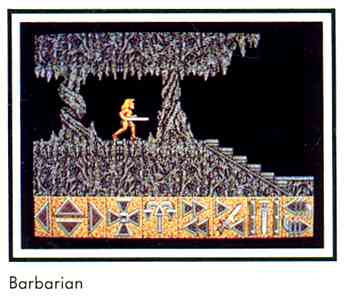
As you guide Hegor, he will encounter all manner of fantastic obstacles: armed opponents, falling rocks, demons, collapsing bridges and the like. Defeating each obstacle is a matter of combining the correct response with a precise sense of timing. Hegor will also find objects which will help him with his quest.
The graphics, animation and sound in Barbarian are the most impressive I've ever seen in an ST game. The backgrounds and opponents are painstakingly detailed, and the motions of Hegor are incredibly realistic. He leaps through the air with fluid motion, and when he walks into a wall and bounces off, his eyes bug out momentarily. The sounds appear to have been digitized, even to the "oof" when he walks into a wall, and the blood-curdling yell when he swings his sword.
There are two problems with Barbarian: one minor, one very major The minor one is that sometimes Hegor appears to walk in mid-air, or his body hangs in mid-air after he has died. The major problem is that there is no way to save the game. This is so important a feature that, as good as Barbarian is, I actually hesitate to recommend it. Frequently, when Hegor enters a new screen, he meets with an immediate peril, you don't have adequate time to respond to it and Hegor bites the dust. A good example of this is the rock that falls on him in the third screen. The next time he enters that screen, you know the rock is there, and after several tries you can figure out how to get past it. But since you can't save a game, you end up playing from the beginning over and over again.
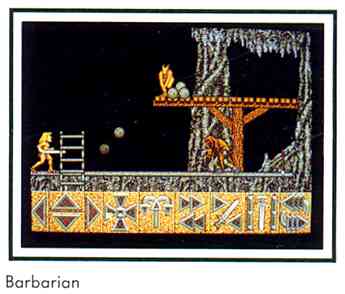
Barbarian is a remarkable effort, with smooth animation, great sound and exquisite graphics. It's a little difficult to control, but you'll be able to master it after some practice. You'll have to balance these good features against the lack of a Save Game option, which I personally found to be a problem.
SUB BATTLE SIMULATOR
Sub Battle Simulator (SBS) is a complex and stimulating recreation
of commanding a submarine during World War II. You have your choice of
commanding either an American Gato-class sub or one of three different
types of German U-boats. Multiple levels and a "practice" mode aid in enjoying
this software.
SBS manages to pack a lot of information into its screens. You have a choice of no less than seven views from the bridge, including periscope (with magnification), binoculars, lookout, radar, sonar, a map display and a unique view from outside your submarine, looking at everything in side view. The latter is especially useful when you're avoiding depth charges.
The map view allows several different levels of zoom, so that you can view the entire operating area in varying degrees of detail. The most detailed view, measuring seven miles on a side, shows all enemy ships at once. Sonar is the only way to track enemy ship movements when underwater, and radar is necessary during poor weather conditions or at night. When using the main view through the periscope or binoculars, you can change the view angle by moving the mouse pointer to the area you want in the center of the view and clicking the button. This does not, however, alter your heading, which can be confusing. To make sure you're moving in the same direction that you're heading, you must press [J].
In addition to the main view, there are four gauges that not only show information about your sub (view angle, heading, speed and depth), but allow you to control the sub with the mouse pointer For example, to change speed, simply click in the speed gauge with the pointer, and the sub will come to the new speed. This makes control pretty straightforward. Other buttons in the main window allow you to crash-dive, surface, charge your battery switch from diesel power to battery, and fire your weapons. There is also an area where messages from the crew are relayed. Another feature you can control from this panel is "time compression," where you can speed up or slow down gameplay so you're not stuck for a long period, wandering around the ocean with nothing to shoot at. Just be sure that you go back to regular time before beginning an attack, or you may find yourself sunk before you know it!
Your sub is equipped with fore and aft torpedo tubes, antiaircraft guns and a deck gun for shelling ships. You can fire all these weapons from the main screen. The guns don't need to be aimed, but the torpedoes do. During an attack, your targeting computer will identify enemy shipping by the ship type, course and heading. Sinking enemy ships is relatively straightforward: line up the ship in the computer and fire a torpedo. Might be a good idea to try this maneuver from periscope depth, since there are planes dropping bombs on you, and everybody is shooting like mad. Run silent and deep when the destroyers come after you.
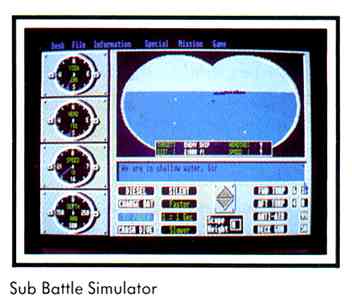
There are a daunting number of things to keep track of in SBS. Almost every key on your keyboard controls a ship function -you can't use just the mouse. Besides the view, weapons and engine controls, you can charge your batteries periodically zoom the map view, abandon ship, send a shore party, transfer torpedos between torpedo rooms, check your coordinates and lay mines. Fortunately, SBS has a pause control, giving you a quick breather while you look over the controls reference card. The manual is superb, telling you not only about the simulation itself, but offering historical data and a short course on submarine tactics.
There are four levels of play in SBS. Not only is finding an enemy convoy harder at the higher levels (they don't show on the map), but damage is more severe, torpedoes don't go as far and don't always explode, and it even takes longer to crash dive. Level four is a killer, suitable only for "real" submarine captains. In addition to these levels, you can choose from among "target practice" mode, a single wartime cruise or an entire wartime command "experience."
The graphics and sound in SBS are good, but not spectacular. Enemy ships are black shapes in the periscope which slowly disappear when sunk, and the sound is limited to some hissing which I assume are bombs and shells. When you're hit. the screen flashes red and there is an uninspired explosion. The fountain of water following a torpedo hit on an enemy ship is well done, however. Messages from the crew tend be extremely repetitous. For example, when I was running, the screen kept telling me that I was too deep. After 30 or 40 times, this got somewhat tiresome! On the other hand, the snotty tone of the crewman when I asked for a lookout view (we were at 300 feet) was amusing.
Sub Battle Simulator
is a complex recreation
of submarine warfare.
Overall, Sub Battle Simulator is well done. At the lower levels, it's challenging but not overwhelmingly difficult for the novice (if you follow the excellent hints in the instruction booklet), while at the upper levels it will challenge the most experienced game players.
That's a wrap for this issue. The games for the next issue are already piling up. See you then!
PRODUCTS MENTIONED
Plutos. Mindscape, 3444 Dundee Road, Northbrook, IL 60062. (312)
480-7667. $29.95
CIRCLE 185 ON READER SERVICE CARD
Airball. MichTron, 576 S. Telegraph, Pontiac, MI 48053. (313) 334-8729.
$29.95
CIRCLE 186 ON READER SERVICE CARD
Barbarian. Psygnosis, Ltd., distributed by CSS, 495-A Busse Road,
Elk Grove Village, IL 60007. (800) 422-4912. $39.95
CIRCLE 187 ON READER SERVICE CARD
Sub Battle Simulator. Epyx, 600 Galveston Drive, Redwood City, CA
94063. (415) 366-0606. $19.95
CIRCLE 188 ON READER SERVICE CARD